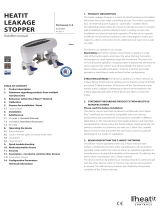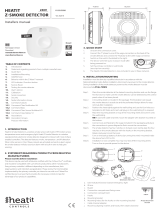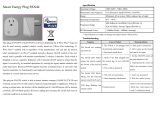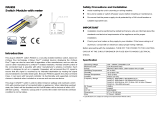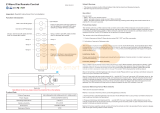
16. ASSOCIATIONS
Z-Wave devices interact with other Z-Wave devices. The relationship
between one device controlling another device is called an association.
In order to control a subordinate device, the controlling device needs
to maintain a list of devices that will receive controlling commands.
These lists are called ”Association Groups”. They are always related to
the specic event triggered (e.g., sensor reports). In case the event is
triggered, all devices stored in the respective association group will
receive a joint wireless command.
16.1 Setting and Removing Associations
Associations may be assigned and removed via Z-Wave commands.
Please refer to your primary controller/Z-Wave gateway for more
information.
17. ASSOCIATION GROUPS
MULTI LEVEL SWITCH DEVICE DESCRIPTION
Group 1
Lifeline
Lifeline. (Normally used by the Z-Wave Controller) Sends:
- Switch Multilevel Report
- Device Reset Notication
- Indicator Report
- Meter Report
- Central Scene Notication
- Conguration Report
Max nodes in group: 5
Group 2
Basic Set
-Basic Set.
Send Basic Set commands representing the status of the dimmer when changed from
S1 or S2.
OFF/ON (0x00, 0xFF)
1-99% (0x01, 0x63)
Max nodes in group: 5
Group 3
Switch Multilevel
-Switch Multilevel
When S1 or S2 is pressed/held
Press: OFF/ON (0x00, 0xFF)
Held: Multilevel Switch Start Level Change/Stop Level Change Command
Level Increase Start / Level Increase Stop
Level Decrease Start / Level Decrease Stop
Max nodes in group: 5
18. CONFIGURATION PARAMETERS
Z-Wave products are supposed to work out of the box after inclusion.
Some device conguration may, however, alter the functionality to
better serve user needs or unlock further enhanced features. All the
parameters below do not feature altering capabilities, advanced or
read only ag.
PA RA
NO#
PARA
SIZE
(BYTE) NAME
SHORT
DESCRIPTION /COMMENT MIN MAX DEFAULT
DESCRIPTION
OF VALUE
1 1 Power restore
level
The state the dimmer
should return to once
power is restored after a
power failure.
0 0 100 O
1 99 1%-99%
100 100 Returns to level before power
outage (Default)
2 1 Switch ON
level
Denes the dimming level
when restored from the
OFF state.
0 0 0 Restores last dim level
(Default)
1 99 1%-99%
3 4 Automatic
turn OFF
Time for the dimmer to
turn o automatically after
turning it on.
0 0 0 Auto OFF disabled (Default)
1 86400 Duration
1-86400 seconds
4 4 Automatic
turn ON
Time for the dimmer to
turn on automatically after
turning it o.
0 0 0 Auto ON disabled (Default)
1 86400 Duration
1-86400 seconds
5 1 Turn o delay
time
The time it takes before
the dimmer turns o after
turning it o.
0 0 0 Disabled (Default)
1 60 Duration
1-60 seconds
12. LED BLINKING PATTERNS DESCRIPTION
The device supports numerous LED blinking patterns to make it as
easy as possible to identify what the device is doing.
Device Not in Network
The LED will ash in red when the device is not added to
a Z-Wave network
0s 1s 2s 3s 4s 5s
Add/Remove
When device enters add/remove mode the LED will
ash green.
If successful, the LED will light up in green for 3 seconds.
If unsuccessful, the LED will light up in red for 3 seconds.
Successful
Unsuccessful
Factory Reset
If the button is pressed for more than 3 seconds, the GREEN
LED will start ashing.
When the button has been pressed for 20 seconds, the
GREEN LED will light up for 3 seconds.
Figure 1 (success)
Within the 3 second period the button must be released.
If the button is released within this period, the device
will reset and start ashing because it is not included
in a gateway.
Figure 2 (fail)
If the button is released before the 3 second period,
the device will indicate fail by turning RED LED on for
3 seconds.
Figure 3 (fail)
The button MUST be released between 20 and 23 seconds
for local reset to take place. If held longer, the device will
ignore the command.
13. QRCODE PLACEMENT DSK
The QR-Code is needed when including a device using S2 security or
SmartStart. The DSK can be found in the QR-Code and is located;
• On the product.
• On the Quick Guide.
• On the gift box.
14. SECURITY
S2 security enhances Z-Wave Plus with an additional layer of AES
128-bit encryption of the wireless Z-Wave communication to prevent
hacking and man-in-middle attacks on the home network. This device
supports S2 and has a Z-Wave DSK QR-Code label that may be used
when the module is added to the Z-Wave home network. The primary
controller will ask for a 5-digit code, which can be found underneath
the QR-Code. The primary controller will then ask you to conrm the
rest of the code that is contained in the QR-Code.
15. NODE INFORMATION FRAME
The node information frame is the ”business card” of a Z-Wave device.
It contains information about the device type and its technical features.
The add and remove procedure of the device is conrmed by sending
out a node information frame. Besides this, it may be necessary for
certain network operations to send out a node information frame.
Figure 1
Release
0s 1s 2s 3s 4s 5s
19s 20s 21s 22s 23s 24s 25s 26s 27s
Figure 2
Released @ x seconds
3<x<20s 6<x+3<23s
0s 1s 2s 3s 4s 5s
Figure 3
0s 1s 2s 3s 4s 19s 20s 21s 22s 23s 24s





